Wireless Communication Assignment: Problems and Detailed Solutions
VerifiedAdded on 2023/01/20
|9
|1396
|40
Homework Assignment
AI Summary
This document presents a comprehensive solution to a wireless communication assignment, covering a range of topics. It begins by using layer models to describe the ordering and delivery of a pizza, followed by a diagram illustrating communication between the French and Chinese prime ministers. The solution then delves into signal analysis, computing the maximum amplitude, frequency, time period, and phase for various waveforms and equations. It also addresses the calculation of source rate and channel capacity for digitized TV pictures, the determination of isotropic free space loss, and the computation of fundamental frequency, spectrum, and bandwidth for a given signal. The assignment further explores methods to increase data rate over a channel, the differences between packet switching and circuit switching, and concludes with calculations for antenna heights in a LOS communication scenario. References are included.
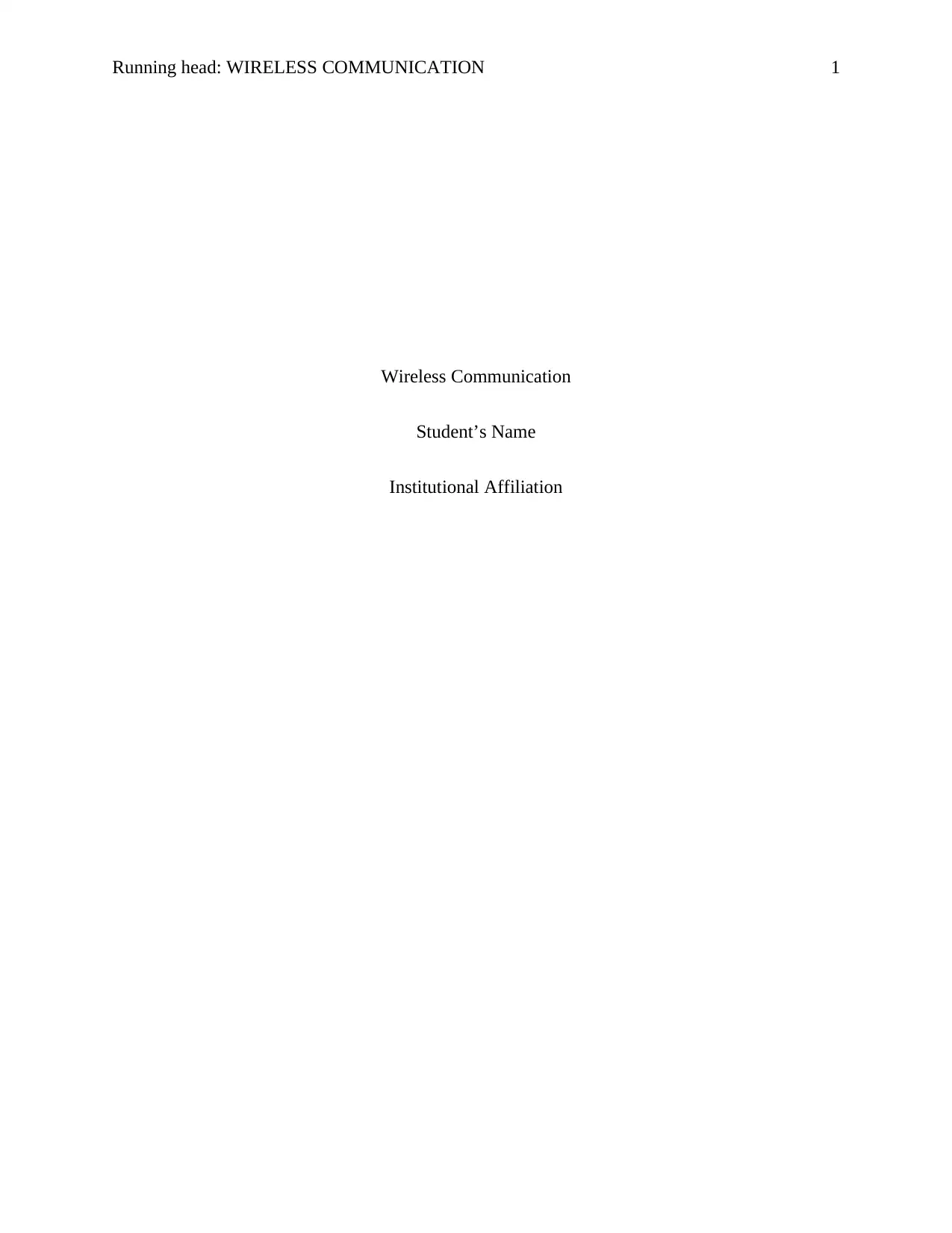
Running head: WIRELESS COMMUNICATION 1
Wireless Communication
Student’s Name
Institutional Affiliation
Wireless Communication
Student’s Name
Institutional Affiliation
Paraphrase This Document
Need a fresh take? Get an instant paraphrase of this document with our AI Paraphraser
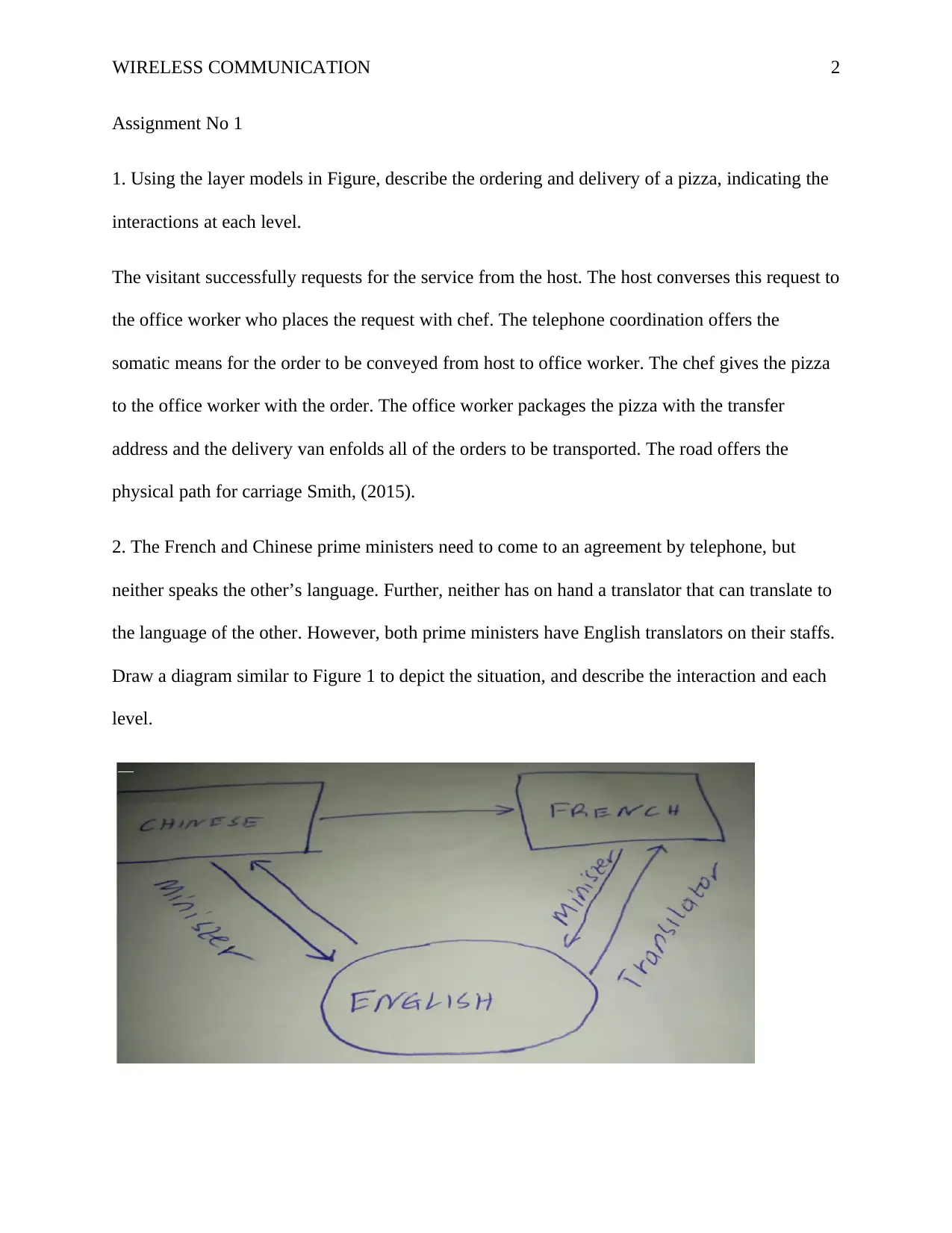
WIRELESS COMMUNICATION 2
Assignment No 1
1. Using the layer models in Figure, describe the ordering and delivery of a pizza, indicating the
interactions at each level.
The visitant successfully requests for the service from the host. The host converses this request to
the office worker who places the request with chef. The telephone coordination offers the
somatic means for the order to be conveyed from host to office worker. The chef gives the pizza
to the office worker with the order. The office worker packages the pizza with the transfer
address and the delivery van enfolds all of the orders to be transported. The road offers the
physical path for carriage Smith, (2015).
2. The French and Chinese prime ministers need to come to an agreement by telephone, but
neither speaks the other’s language. Further, neither has on hand a translator that can translate to
the language of the other. However, both prime ministers have English translators on their staffs.
Draw a diagram similar to Figure 1 to depict the situation, and describe the interaction and each
level.
Assignment No 1
1. Using the layer models in Figure, describe the ordering and delivery of a pizza, indicating the
interactions at each level.
The visitant successfully requests for the service from the host. The host converses this request to
the office worker who places the request with chef. The telephone coordination offers the
somatic means for the order to be conveyed from host to office worker. The chef gives the pizza
to the office worker with the order. The office worker packages the pizza with the transfer
address and the delivery van enfolds all of the orders to be transported. The road offers the
physical path for carriage Smith, (2015).
2. The French and Chinese prime ministers need to come to an agreement by telephone, but
neither speaks the other’s language. Further, neither has on hand a translator that can translate to
the language of the other. However, both prime ministers have English translators on their staffs.
Draw a diagram similar to Figure 1 to depict the situation, and describe the interaction and each
level.

WIRELESS COMMUNICATION 3
The French prime minister converses in French to English translator. The second translator
translates English to Chinese minister. The response then trails the loop but in the opposite trend
Puppis, (2016).
3. From the following figures, compute the maximum amplitude, frequency, time period and
phase for each of the wave. The x-axis represents the time in sec and y-axis represents the
amplitude.
Figure 1
Maximum amplitude =15
Time period= 3s
Frequency: 1/3=0.3333 Hz
Phase: 0
Figure 2
Maximum amplitude = 4
Time period= 6.4s
Frequency:1/6.4=0.15625 Hz
Phase: 0
Figure 3
Maximum amplitude =7.8
Time period= 2.2s
The French prime minister converses in French to English translator. The second translator
translates English to Chinese minister. The response then trails the loop but in the opposite trend
Puppis, (2016).
3. From the following figures, compute the maximum amplitude, frequency, time period and
phase for each of the wave. The x-axis represents the time in sec and y-axis represents the
amplitude.
Figure 1
Maximum amplitude =15
Time period= 3s
Frequency: 1/3=0.3333 Hz
Phase: 0
Figure 2
Maximum amplitude = 4
Time period= 6.4s
Frequency:1/6.4=0.15625 Hz
Phase: 0
Figure 3
Maximum amplitude =7.8
Time period= 2.2s
⊘ This is a preview!⊘
Do you want full access?
Subscribe today to unlock all pages.

Trusted by 1+ million students worldwide
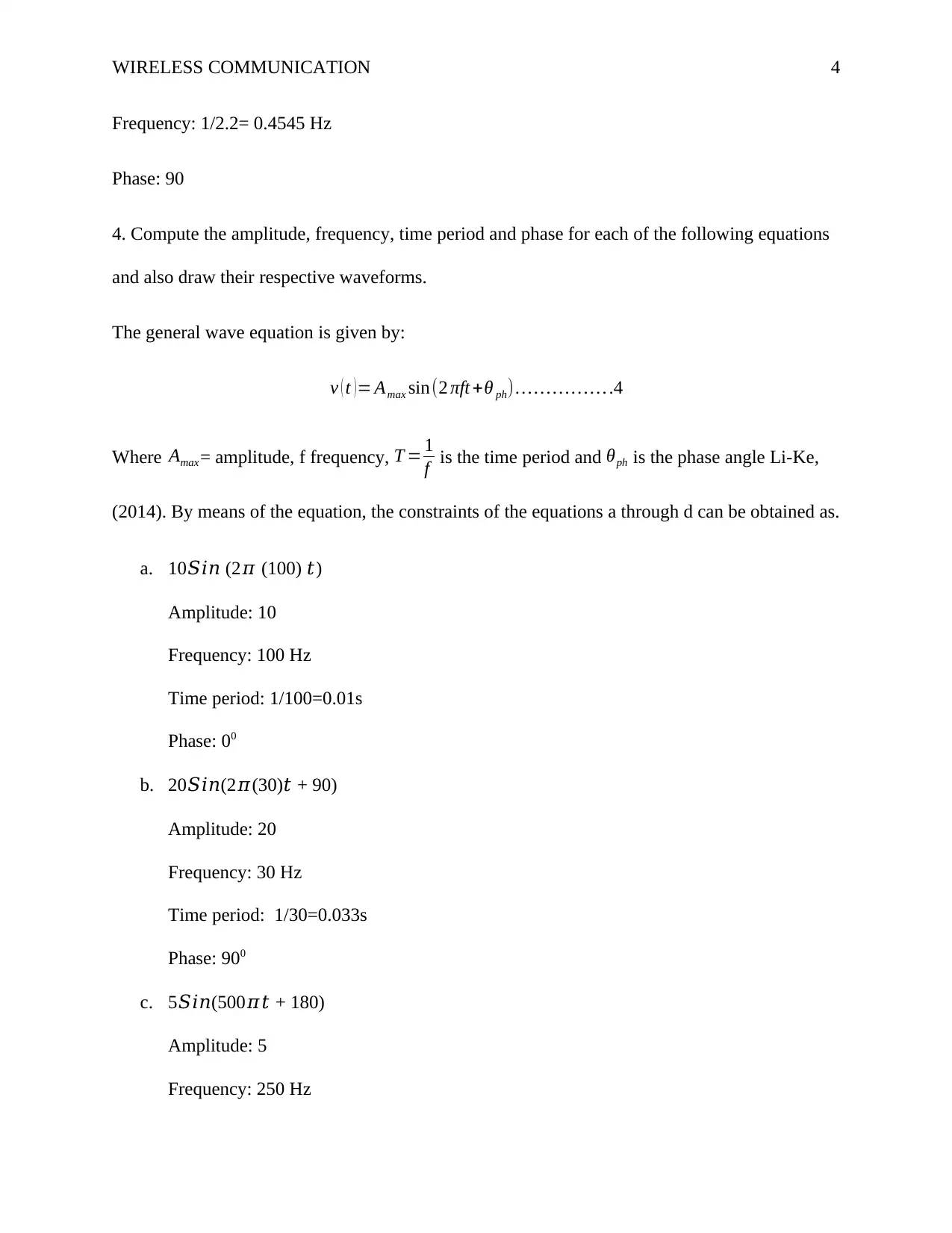
WIRELESS COMMUNICATION 4
Frequency: 1/2.2= 0.4545 Hz
Phase: 90
4. Compute the amplitude, frequency, time period and phase for each of the following equations
and also draw their respective waveforms.
The general wave equation is given by:
v ( t )= Amax sin(2 πft +θ ph) … … … … … .4
Where Amax= amplitude, f frequency, T = 1
f is the time period and θph is the phase angle Li-Ke,
(2014). By means of the equation, the constraints of the equations a through d can be obtained as.
a. 10𝑆𝑖𝑛 (2𝜋 (100) 𝑡)
Amplitude: 10
Frequency: 100 Hz
Time period: 1/100=0.01s
Phase: 00
b. 20𝑆𝑖𝑛(2𝜋(30)𝑡 + 90)
Amplitude: 20
Frequency: 30 Hz
Time period: 1/30=0.033s
Phase: 900
c. 5𝑆𝑖𝑛(500𝜋𝑡 + 180)
Amplitude: 5
Frequency: 250 Hz
Frequency: 1/2.2= 0.4545 Hz
Phase: 90
4. Compute the amplitude, frequency, time period and phase for each of the following equations
and also draw their respective waveforms.
The general wave equation is given by:
v ( t )= Amax sin(2 πft +θ ph) … … … … … .4
Where Amax= amplitude, f frequency, T = 1
f is the time period and θph is the phase angle Li-Ke,
(2014). By means of the equation, the constraints of the equations a through d can be obtained as.
a. 10𝑆𝑖𝑛 (2𝜋 (100) 𝑡)
Amplitude: 10
Frequency: 100 Hz
Time period: 1/100=0.01s
Phase: 00
b. 20𝑆𝑖𝑛(2𝜋(30)𝑡 + 90)
Amplitude: 20
Frequency: 30 Hz
Time period: 1/30=0.033s
Phase: 900
c. 5𝑆𝑖𝑛(500𝜋𝑡 + 180)
Amplitude: 5
Frequency: 250 Hz
Paraphrase This Document
Need a fresh take? Get an instant paraphrase of this document with our AI Paraphraser

WIRELESS COMMUNICATION 5
Time period: 1/250=0.004s
Phase: 1800
d. 8𝑆𝑖𝑛 (400𝜋𝑡 + 270)
Amplitude: 8
Frequency: 200 Hz
Time period: 1/200=0.005s
Phase: 2700
5. Suppose that a digitized TV picture is to be transmitted from a source that uses a matrix of
480× 500 picture elements (pixels), where each pixel can take on one of 32 intensity values.
Assume that 30 pictures are sent per second. (This digital source is roughly equivalent to
broadcast TV standards that have been adopted.).
a. Find the source rate R (bps).
R=30∗450∗500∗5
¿ 7.2∗106 pixels
s
¿ 36 mbps
b. Assume that the TV picture is to be transmitted over a channel with 4.5-MHz
bandwidth and a 35-dB signal-to-noise ratio. Find the capacity of the channel
(bps). Hint: Use Shannon’s Criteria.
c=B log10 ( 1+SNR )
¿ 4.5∗106 log10 ( 1+ 3162 )
Time period: 1/250=0.004s
Phase: 1800
d. 8𝑆𝑖𝑛 (400𝜋𝑡 + 270)
Amplitude: 8
Frequency: 200 Hz
Time period: 1/200=0.005s
Phase: 2700
5. Suppose that a digitized TV picture is to be transmitted from a source that uses a matrix of
480× 500 picture elements (pixels), where each pixel can take on one of 32 intensity values.
Assume that 30 pictures are sent per second. (This digital source is roughly equivalent to
broadcast TV standards that have been adopted.).
a. Find the source rate R (bps).
R=30∗450∗500∗5
¿ 7.2∗106 pixels
s
¿ 36 mbps
b. Assume that the TV picture is to be transmitted over a channel with 4.5-MHz
bandwidth and a 35-dB signal-to-noise ratio. Find the capacity of the channel
(bps). Hint: Use Shannon’s Criteria.
c=B log10 ( 1+SNR )
¿ 4.5∗106 log10 ( 1+ 3162 )
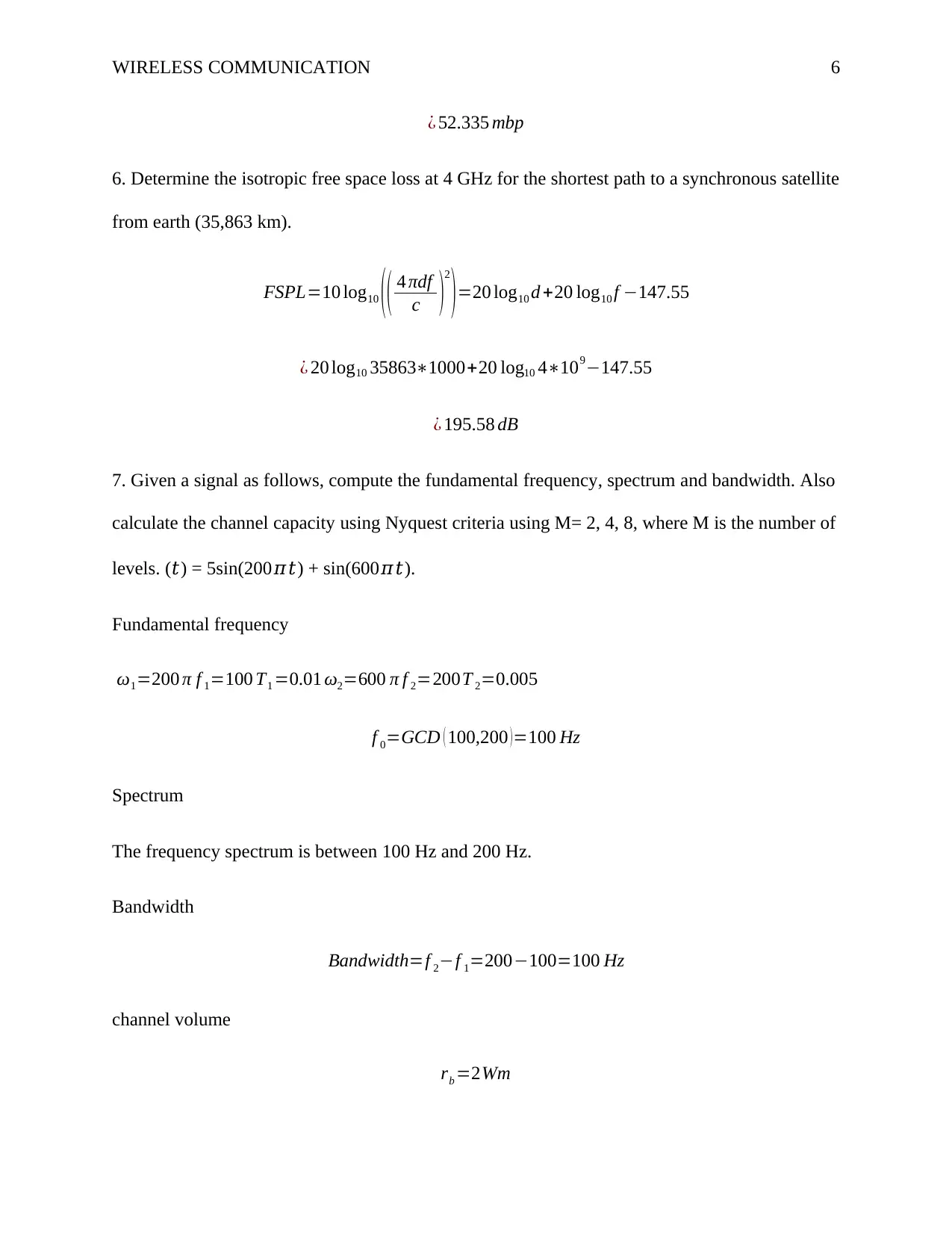
WIRELESS COMMUNICATION 6
¿ 52.335 mbp
6. Determine the isotropic free space loss at 4 GHz for the shortest path to a synchronous satellite
from earth (35,863 km).
FSPL=10 log10 (( 4 πdf
c )2
)=20 log10 d +20 log10 f −147.55
¿ 20 log10 35863∗1000+20 log10 4∗109−147.55
¿ 195.58 dB
7. Given a signal as follows, compute the fundamental frequency, spectrum and bandwidth. Also
calculate the channel capacity using Nyquest criteria using M= 2, 4, 8, where M is the number of
levels. (𝑡) = 5sin(200𝜋𝑡) + sin(600𝜋𝑡).
Fundamental frequency
ω1=200 π f 1=100 T1 =0.01 ω2=600 π f 2=200T 2=0.005
f 0=GCD ( 100,200 ) =100 Hz
Spectrum
The frequency spectrum is between 100 Hz and 200 Hz.
Bandwidth
Bandwidth=f 2−f 1=200−100=100 Hz
channel volume
rb =2Wm
¿ 52.335 mbp
6. Determine the isotropic free space loss at 4 GHz for the shortest path to a synchronous satellite
from earth (35,863 km).
FSPL=10 log10 (( 4 πdf
c )2
)=20 log10 d +20 log10 f −147.55
¿ 20 log10 35863∗1000+20 log10 4∗109−147.55
¿ 195.58 dB
7. Given a signal as follows, compute the fundamental frequency, spectrum and bandwidth. Also
calculate the channel capacity using Nyquest criteria using M= 2, 4, 8, where M is the number of
levels. (𝑡) = 5sin(200𝜋𝑡) + sin(600𝜋𝑡).
Fundamental frequency
ω1=200 π f 1=100 T1 =0.01 ω2=600 π f 2=200T 2=0.005
f 0=GCD ( 100,200 ) =100 Hz
Spectrum
The frequency spectrum is between 100 Hz and 200 Hz.
Bandwidth
Bandwidth=f 2−f 1=200−100=100 Hz
channel volume
rb =2Wm
⊘ This is a preview!⊘
Do you want full access?
Subscribe today to unlock all pages.

Trusted by 1+ million students worldwide
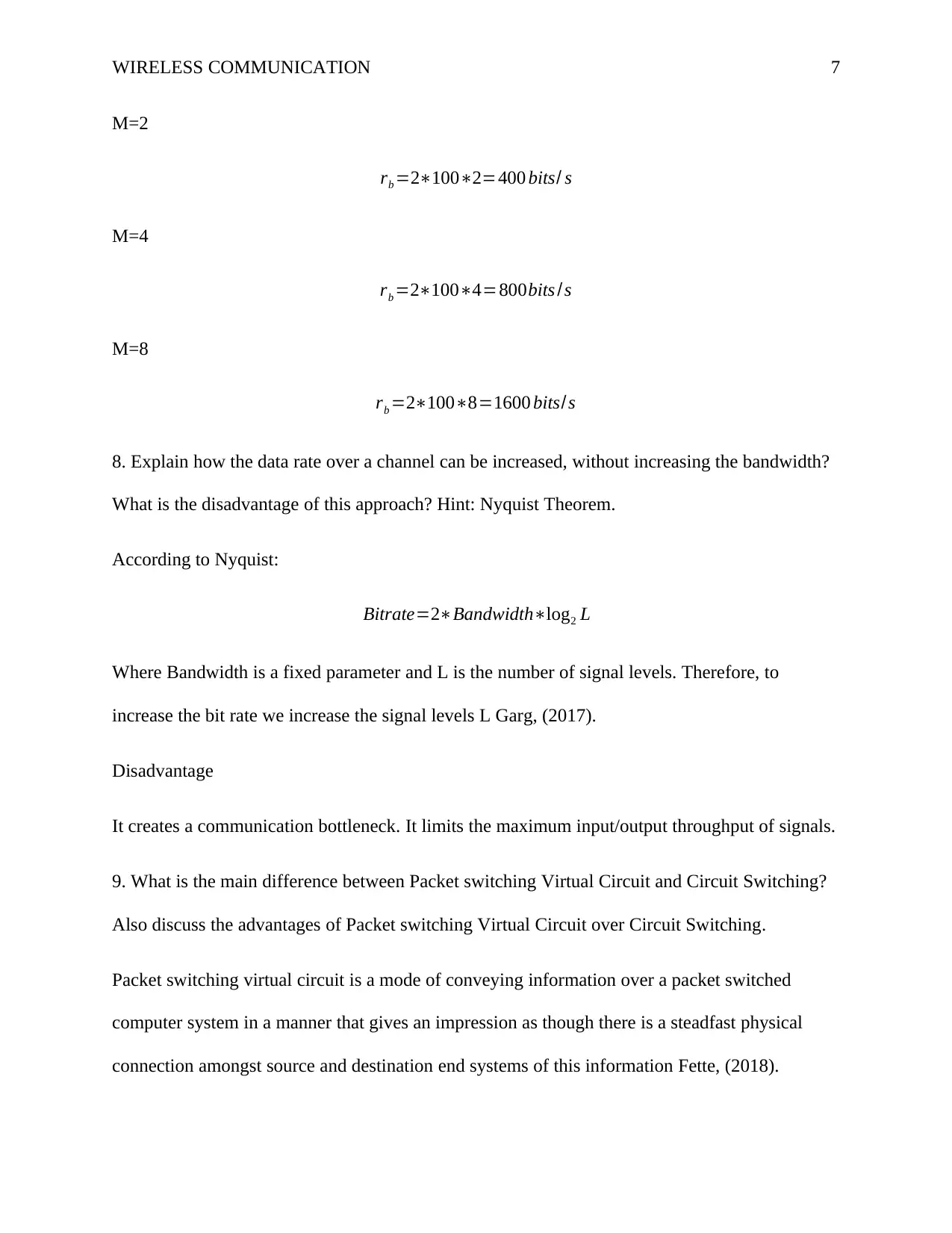
WIRELESS COMMUNICATION 7
M=2
rb =2∗100∗2=400 bits/ s
M=4
rb =2∗100∗4=800bits /s
M=8
rb =2∗100∗8=1600 bits/s
8. Explain how the data rate over a channel can be increased, without increasing the bandwidth?
What is the disadvantage of this approach? Hint: Nyquist Theorem.
According to Nyquist:
Bitrate=2∗Bandwidth∗log2 L
Where Bandwidth is a fixed parameter and L is the number of signal levels. Therefore, to
increase the bit rate we increase the signal levels L Garg, (2017).
Disadvantage
It creates a communication bottleneck. It limits the maximum input/output throughput of signals.
9. What is the main difference between Packet switching Virtual Circuit and Circuit Switching?
Also discuss the advantages of Packet switching Virtual Circuit over Circuit Switching.
Packet switching virtual circuit is a mode of conveying information over a packet switched
computer system in a manner that gives an impression as though there is a steadfast physical
connection amongst source and destination end systems of this information Fette, (2018).
M=2
rb =2∗100∗2=400 bits/ s
M=4
rb =2∗100∗4=800bits /s
M=8
rb =2∗100∗8=1600 bits/s
8. Explain how the data rate over a channel can be increased, without increasing the bandwidth?
What is the disadvantage of this approach? Hint: Nyquist Theorem.
According to Nyquist:
Bitrate=2∗Bandwidth∗log2 L
Where Bandwidth is a fixed parameter and L is the number of signal levels. Therefore, to
increase the bit rate we increase the signal levels L Garg, (2017).
Disadvantage
It creates a communication bottleneck. It limits the maximum input/output throughput of signals.
9. What is the main difference between Packet switching Virtual Circuit and Circuit Switching?
Also discuss the advantages of Packet switching Virtual Circuit over Circuit Switching.
Packet switching virtual circuit is a mode of conveying information over a packet switched
computer system in a manner that gives an impression as though there is a steadfast physical
connection amongst source and destination end systems of this information Fette, (2018).
Paraphrase This Document
Need a fresh take? Get an instant paraphrase of this document with our AI Paraphraser

WIRELESS COMMUNICATION 8
In a circuit-switched network, when two nodes need to communicate, a direct and continuous
connection is established between them. It carries only the one conversation, for as long as it
lasts.
On the other hand, a packet-switched network, data is divided into chunks, or packets. The
packets have headers attached to them to identify them for example, by source, destination and
sequence number and are intermingled with the packets of other conversations on a shared
network Fette, (2018).
Benefits of Packet switching Virtual Circuit over Circuit Switching
i. It is stress-free and more reasonably priced.
ii. Necessitates less complex infrastructure.
iii. Tranquil to add new nodes to the system.
10. In a LOS communication, consider d = 40km, the requirement is to make two antennas
(transmitter and receiver) such that the height of one antenna should be twice of the other.
Considering this, find the appropriate heights of these two antennas.
d=3.57( √k h1 + √k h2 )
h1=2h2
k =0.8
Therefore:
40=3.57 ( √0.8 h1 + √0.8 h1 )=3.57∗2 √0.8 h1
h1=39.23m , h2=19.615 m
In a circuit-switched network, when two nodes need to communicate, a direct and continuous
connection is established between them. It carries only the one conversation, for as long as it
lasts.
On the other hand, a packet-switched network, data is divided into chunks, or packets. The
packets have headers attached to them to identify them for example, by source, destination and
sequence number and are intermingled with the packets of other conversations on a shared
network Fette, (2018).
Benefits of Packet switching Virtual Circuit over Circuit Switching
i. It is stress-free and more reasonably priced.
ii. Necessitates less complex infrastructure.
iii. Tranquil to add new nodes to the system.
10. In a LOS communication, consider d = 40km, the requirement is to make two antennas
(transmitter and receiver) such that the height of one antenna should be twice of the other.
Considering this, find the appropriate heights of these two antennas.
d=3.57( √k h1 + √k h2 )
h1=2h2
k =0.8
Therefore:
40=3.57 ( √0.8 h1 + √0.8 h1 )=3.57∗2 √0.8 h1
h1=39.23m , h2=19.615 m
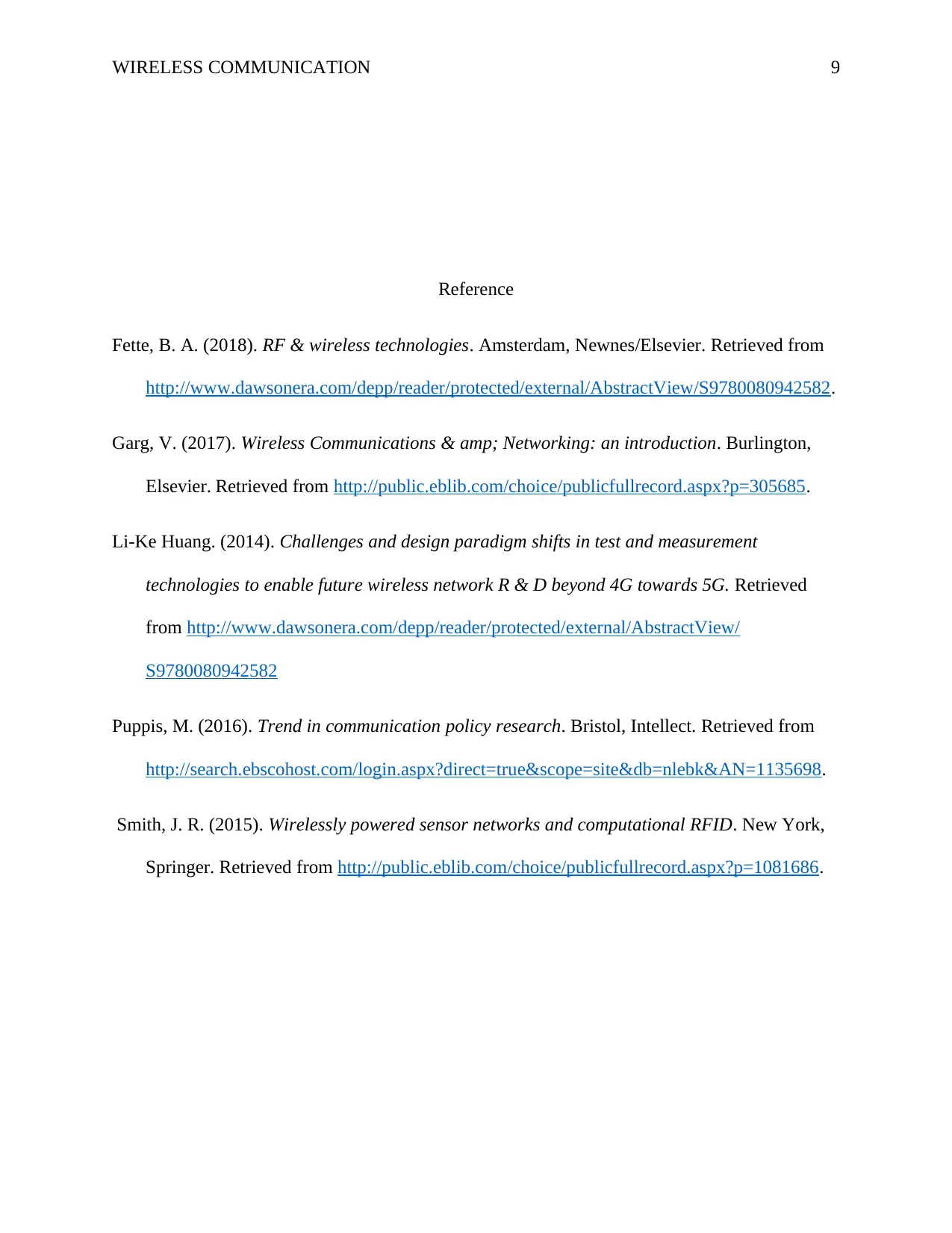
WIRELESS COMMUNICATION 9
Reference
Fette, B. A. (2018). RF & wireless technologies. Amsterdam, Newnes/Elsevier. Retrieved from
http://www.dawsonera.com/depp/reader/protected/external/AbstractView/S9780080942582.
Garg, V. (2017). Wireless Communications & amp; Networking: an introduction. Burlington,
Elsevier. Retrieved from http://public.eblib.com/choice/publicfullrecord.aspx?p=305685.
Li-Ke Huang. (2014). Challenges and design paradigm shifts in test and measurement
technologies to enable future wireless network R & D beyond 4G towards 5G. Retrieved
from http://www.dawsonera.com/depp/reader/protected/external/AbstractView/
S9780080942582
Puppis, M. (2016). Trend in communication policy research. Bristol, Intellect. Retrieved from
http://search.ebscohost.com/login.aspx?direct=true&scope=site&db=nlebk&AN=1135698.
Smith, J. R. (2015). Wirelessly powered sensor networks and computational RFID. New York,
Springer. Retrieved from http://public.eblib.com/choice/publicfullrecord.aspx?p=1081686.
Reference
Fette, B. A. (2018). RF & wireless technologies. Amsterdam, Newnes/Elsevier. Retrieved from
http://www.dawsonera.com/depp/reader/protected/external/AbstractView/S9780080942582.
Garg, V. (2017). Wireless Communications & amp; Networking: an introduction. Burlington,
Elsevier. Retrieved from http://public.eblib.com/choice/publicfullrecord.aspx?p=305685.
Li-Ke Huang. (2014). Challenges and design paradigm shifts in test and measurement
technologies to enable future wireless network R & D beyond 4G towards 5G. Retrieved
from http://www.dawsonera.com/depp/reader/protected/external/AbstractView/
S9780080942582
Puppis, M. (2016). Trend in communication policy research. Bristol, Intellect. Retrieved from
http://search.ebscohost.com/login.aspx?direct=true&scope=site&db=nlebk&AN=1135698.
Smith, J. R. (2015). Wirelessly powered sensor networks and computational RFID. New York,
Springer. Retrieved from http://public.eblib.com/choice/publicfullrecord.aspx?p=1081686.
⊘ This is a preview!⊘
Do you want full access?
Subscribe today to unlock all pages.

Trusted by 1+ million students worldwide
1 out of 9
Related Documents
Your All-in-One AI-Powered Toolkit for Academic Success.
+13062052269
info@desklib.com
Available 24*7 on WhatsApp / Email
![[object Object]](/_next/static/media/star-bottom.7253800d.svg)
Unlock your academic potential
Copyright © 2020–2025 A2Z Services. All Rights Reserved. Developed and managed by ZUCOL.




